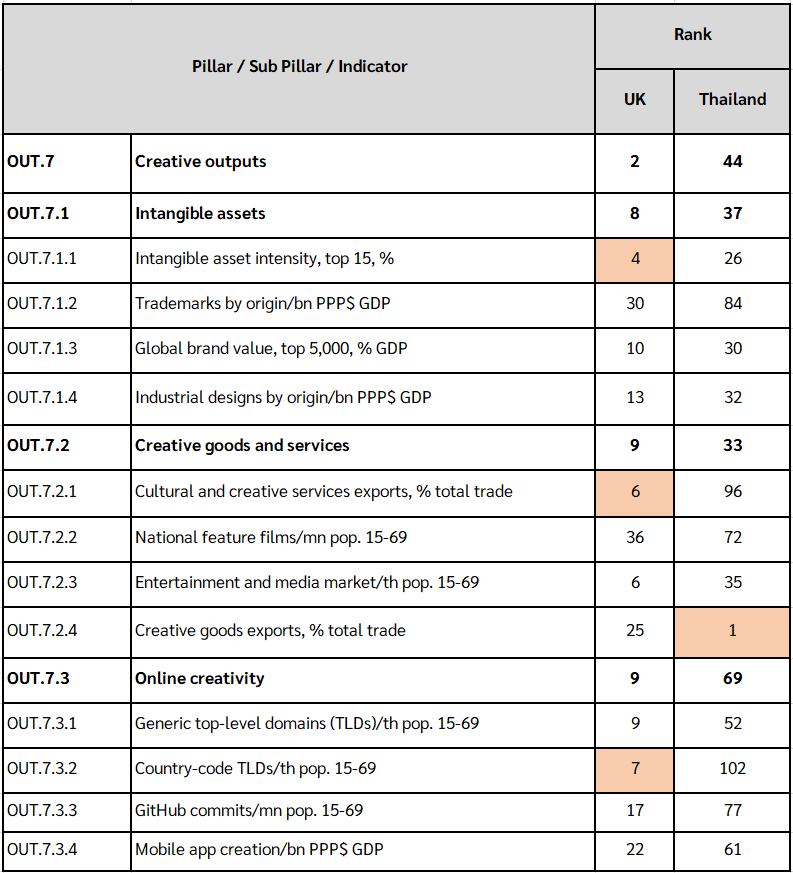ส่องวิสัยทัศน์ 2030 เศรษฐกิจสร้างสรรค์ UK ความเหมือนที่แตกต่างกับไทย

เส้นทางพัฒนาสู่ปี 2030 เศรษฐกิจสร้างสรรค์ UK มุ่งเป้าชู RDI และ Soft Power ดันมูลค่าอุตสาหกรรมโตเพิ่ม 5 หมื่นล้านปอนด์ เหมือนหรือต่างกับไทยอย่างไร
เศรษฐกิจสร้างสรรค์ไทยในช่วงทศวรรษที่ผ่านมา มีแนวโน้มเติบโตต่อเนื่อง แม้จะสะดุดไปบ้างจากสถานการณ์โควิด แต่ปัจจุบันก็เริ่มกลับมาเติบโตตามหนทางที่ควรจะเป็น โดยมีสัดส่วนมูลค่าเพิ่มรวมของอุตสาหกรรมสร้างสรรค์ หรือ Gross Value Added (GVA) อยู่ที่ร้อยละ 6.81 ต่อจีดีพีประเทศ สร้างการจ้างงานราว 9.6 แสนคน หากเทียบกับสหราชอาณาจักร หรือ UK ซึ่งไทยได้รับอิทธิพลในการวางรากฐานระบบเศรษฐกิจสร้างสรรค์มาจากประเทศนี้ค่อนข้างมาก ปัจจุบัน UK มีมูลค่าอุตสาหกรรมสร้างสรรค์สูงกว่าไทยประมาณ 3.5 เท่า
UK ได้ออกรายงาน “Creative industries sector vision: a joint plan to drive growth, build talent and develop skills” ที่ชูให้โลกเห็นถึงวิสัยทัศน์การพัฒนาอุตสาหกรรมสร้างสรรค์ในปัจจุบันจนถึงปี 2030 “ริชี ซูแน็ก” นายกรัฐมนตรีของ UK ได้กล่าวไว้ในคำนำของรายงานว่า “การเติบโตทางเศรษฐกิจของประเทศ = การเติบโตของอุตสาหกรรมสร้างสรรค์” เพราะเป็นอุตสาหกรรมที่สร้างมูลค่าเพิ่มให้ประเทศกว่า 1.08 แสนล้านปอนด์ต่อปี เกิดการจ้างงานมากกว่า 2.3 ล้านคน โดยวางเป้าที่จะดันให้อุตสาหกรรมสร้างสรรค์โตเพิ่มขึ้นอีก 5 หมื่นล้านปอนด์ภายในปี 2030 ซึ่งความทะเยอทะยานนี้ถูกคิดขึ้นอย่างเป็นระบบ ผ่านการส่งเสริมเรื่องการวิจัย พัฒนาและนวัตกรรม (RDI) และการเพิ่มแต้มต่อในการลงทุนให้กับธุรกิจสร้างสรรค์ นำไปสู่การส่งออกสินค้าและบริการที่จะสร้างเม็ดเงินเข้าประเทศให้ได้ถึง 1 ล้านล้านปอนด์ นอกเหนือจากเป้าหมายทางเศรษฐกิจแล้ว UK ยังให้ความสำคัญกับการพัฒนาทักษะแรงงานรองรับอนาคต ยกระดับคุณภาพชีวิตของประชาชน และเสริมสร้างซอฟต์พาวเวอร์ของประเทศด้วย
2030 Goals and Objectives

แหล่งข้อมูล: www.gov.uk/government/publications/creative-industries-sector-vision
ประเด็นที่น่าสนใจของวิสัยทัศน์ 2030 ของ UK ที่อุตสาหกรรมสร้างสรรค์ไทยยังไม่ได้พูดถึงมากนัก คือเรื่องของการลงทุนด้าน RDI เพื่อพัฒนาผลผลิตด้านสร้างสรรค์ ซึ่ง UK ให้ความสำคัญอย่างมาก มุ่งเป้าที่จะเพิ่มค่าใช้จ่ายด้าน RDI ระหว่างรัฐร่วมเอกชนในสัดส่วนสูงถึงร้อยละ 3.2 ของมูลค่า GVA ประเทศ โดยเน้นไปที่การพัฒนาเทคโนโลยีเรือธงอย่าง AI และเทคโนโลยีเสมือน (Immersive Technology) ซึ่งต่างจากไทยที่ RDI มักถูกมองเป็นทิศทางการพัฒนาของกลุ่ม Real Sector เป็นหลัก
ผลลัพธ์ทางเศรษฐกิจเป็นภาพสะท้อนจากแนวคิดและรากฐานการผลิตเดิมของแต่ละประเทศ
ชวนมาพิจารณาความแตกต่างในแนวทางการพัฒนาผลผลิตด้านสร้างสรรค์ระหว่างไทยและ UK ผ่านดัชนีนวัตกรรมโลก หรือ Global Innovation Index (GII) ซึ่งมีดัชนีย่อยที่วัดผลผลิตด้านความคิดสร้างสรรค์ (Creative Outputs) หากจะเปรียบเทียบระดับความสามารถของไทยกับ UK จากการจัดอันดับในปี 2023

แหล่งข้อมูล: www.wipo.int/global_innovation_index/en/2023
จะสังเกตได้ว่าตัวชี้วัดที่ไทยมีจุดแข็ง คือ เรื่องการส่งออกสินค้าสร้างสรรค์ ซึ่งได้อันดับ 1 ของโลกร่วมกับอีก 6 ประเทศ ปัจจุบันไทยมีสัดส่วนมูลค่าการส่งออกสินค้าสร้างสรรค์อยู่ที่ร้อยละ 2.38 ของมูลค่าการส่งออกรวม โดยกลุ่มสินค้าสำคัญได้แก่ สินค้าไลฟ์สไตล์และงานฝีมือ ซึ่งสอดคล้องกับมูลค่า GVA สูงสุด 6 อันดับแรกของไทย ประกอบไปด้วยสาขาแฟชั่น ออกแบบ และคราฟต์
ในทางกลับกันตัวชี้วัดที่เป็นจุดแข็งของ UK อยู่ที่สินทรัพย์ที่จับต้องไม่ได้ (Intangible Assets) อันได้แก่ มูลค่าแบรนด์และทรัพย์สินทางปัญญาในประเทศ รวมไปถึงการส่งออกวัฒนธรรมและบริการสร้างสรรค์ (Cultural and creative services exports) ซึ่งสอดรับกับตัวเลข GVA รายสาขาของ UK พบว่า สาขาที่สร้างมูลค่าเพิ่มได้สูงที่สุดคือ IT, Software & Computer Services อยู่ที่ร้อยละ 41.27 รองลงมาคือ สาขา Advertising & Marketing ร้อยละ 18.28 จากข้อมูลในข้างต้นแสดงให้เห็นถึงโฟกัสที่ต่างกันของอุตสาหกรรมสร้างสรรค์ระหว่างสองประเทศ
นอกจากนี้ UK ยังมีอีกเป้าหมายที่คล้ายคลึงกับรัฐบาลไทย คือ สนับสนุนการสร้างซอฟต์พาวเวอร์ของประเทศ โดยเน้นไปที่การใช้อุตสาหกรรมสร้างสรรค์เป็นเครื่องมือสร้างอิทธิพลเชิงบวกบนเวทีโลก ตามกรอบวิสัยทัศน์ปี 2030 UK จะยังคงมุ่งมั่นรักษาตำแหน่งในฐานะศูนย์กลางด้านวัฒนธรรมและอุตสาหกรรมสร้างสรรค์ ขยายผลชื่อเสียงเพื่อดึงดูดและสร้างแรงบันดาลใจให้กับประเทศอื่น ๆ ทั่วโลก พร้อมขับเคลื่อนร่วมกับเอกชนขยายการส่งออกสินค้า ดิจิทัลคอนเทนต์ และบริการ ในกลุ่มภาพยนตร์ เพลง แฟชั่น และเทศกาล ควบคู่ไปกับการสร้างเมืองแห่งวัฒนธรรม (City of Culture) เพื่อดึงดูดการลงทุนใหม่ ๆ โดยเฉพาะกิจกรรมและแพลตฟอร์มเทศกาลที่มีชื่อเสียงในระดับโลก เช่น South By Southwest, Venice Biennale และ Seasons of Culture ให้มาจัดที่ UK โดยมีตัวอย่างนโยบาย โครงการ และเม็ดเงินการลงทุนของรัฐบาลที่จะใส่เข้าไปเพื่อปลดล็อกศักยภาพของอุตสาหกรรมสร้างสรรค์กว่า 77 ล้านปอนด์ ให้บรรลุผลสำเร็จตามเป้าหมายหลักของวิสัยทัศน์ทั้ง 3 ข้อ รายละเอียดปรากฏดังตาราง
Policies and programmes that government and industry will collaborate on to deliver
| Goal 1: Unlock the potential that exists in the creative industries to drive growth across the economy. |
Goal 2: Build a pipeline of talent into the creative industries. |
Goal 3: Enhance the creative industries’ ability to enrich lives, create pride in place and strengthen soft power. |
|
- deliver the next £50 million wave of the Creative Industries Clusters Programme to support R&D in at least 6 new clusters. - provide £75.6 million to set up 4 new R&D labs and an Insight Foresight Unit across the UK as part of the Convergent Screen Technologies and Performance in Realtime (CoSTAR) programme. - increase the Create Growth Programme’s (CGP) budget by £10.9 million to a total of £28.4 million to support businesses in another 6 English regions. - provide an additional £5 million for the UK Games Fund to invest in early-stage games studios, bringing its total value to £13.4 million. - extend and increase funding for Arts Council England’s (ACE) Supporting Grassroots Live Music fund with an additional £5m over the next 2 years. - triple the funding for the Music Export Growth Scheme (MEGS) to £3.2 million over 2023-25 to enable emerging artists to break into new international markets. - in partnership with the Royal Anniversary Trust, launch a challenge designed to encourage innovation and growth in the creative industries. - welcome the recommendations of the Pro-innovation Regulation of Technologies Review and make rapid progress to develop a code of practice on text and data mining to ensure creator rights are appropriately protected. |
- publish a new Cultural Education Plan (CEP) in 2023, deliver the National Plan for Music Education (NPME) including £25 million for musical instruments, and explore opportunities for enrichment activities as part of the government’s wraparound childcare provision. - publish a new Cultural Education Plan (CEP) in 2023, deliver the National Plan for Music Education (NPME) including £25 million for musical instruments, and explore opportunities for enrichment activities as part of the government’s wraparound childcare provision. - improve creative apprenticeships, with regards to Small and Medium Enterprise (SME) engagement, training provision, relevance of standards and the effectiveness and sustainability of the Flexi-Job Model. - support the rollout of T-Levels, and complementary high-quality, employer-led Level 3 qualifications that focus on good progression outcomes. - work with industry so that they can take advantage of Skills Bootcamps at national and regional levels, and benefit from new Local Skills Improvement Plans (LSIPs) and the forthcoming Lifelong Loan Entitlement. - set out, with industry, an action plan in response to the independent Good Work Review: Job Quality in the Creative Industries. The CIC will launch a Charting Progress Tool to track the effectiveness of diversity and inclusion interventions. |
- deliver on the government’s commitment to support creative excellence. - supporting and promoting the very top end of our cultural and creative output to enhance soft power and boost exports. The government will provide new funding of £2 million to London Fashion Week to support 5 fashion weeks from 2023-25 and £1.7 million to the London Film Festival 2024. - deliver the £80 million Research infrastructure for conservation and heritage science (RICHeS) programme to secure the UK’s reputation for excellence in conservation and heritage science. - deliver the Music Venue Trust’s £3.5 million Own Our Venues pilot. - implement the broadcasting white paper. - introduce an industry-led Creative Climate Charter. - support Bradford to deliver the next UK City of Culture in 2025.
|
แหล่งข้อมูล: www.gov.uk/government/publications/creative-industries-sector-vision
โดยสรุปหากมองภาพทั้งในปัจจุบันและอนาคต ระบบเศรษฐกิจสร้างสรรค์ของไทยและ UK ล้วนมีทิศทางการพัฒนาที่ใกล้เคียงกัน
จุดวัดความสำเร็จคงอยู่ที่วิสัยทัศน์และการให้ความสำคัญกับภาคส่วนนี้ของรัฐบาล เม็ดเงินที่จะใส่เข้ามาเพื่อเอื้อให้เกิดการเติบโต การวิจัยและพัฒนาองค์ความรู้ใหม่ ๆ รวมไปถึงความพร้อมของธุรกิจและทักษะของแรงงานรองรับการเปลี่ยนแปลงในอนาคต ซึ่งต้องอาศัยความร่วมมือจากทั้งรัฐ การศึกษา และเอกชน เพื่อดันให้เศรษฐกิจสร้างสรรค์กลายเป็นเครื่องมือหนึ่งในการสร้างไทยพาวเวอร์เพื่อแข่งขันบนเวทีโลกได้จริง
ผู้เขียน: ศูนย์ข้อมูลเศรษฐกิจสร้างสรรค์ สำนักงานส่งเสริมเศรษฐกิจสร้างสรรค์ (องค์การมหาชน)

